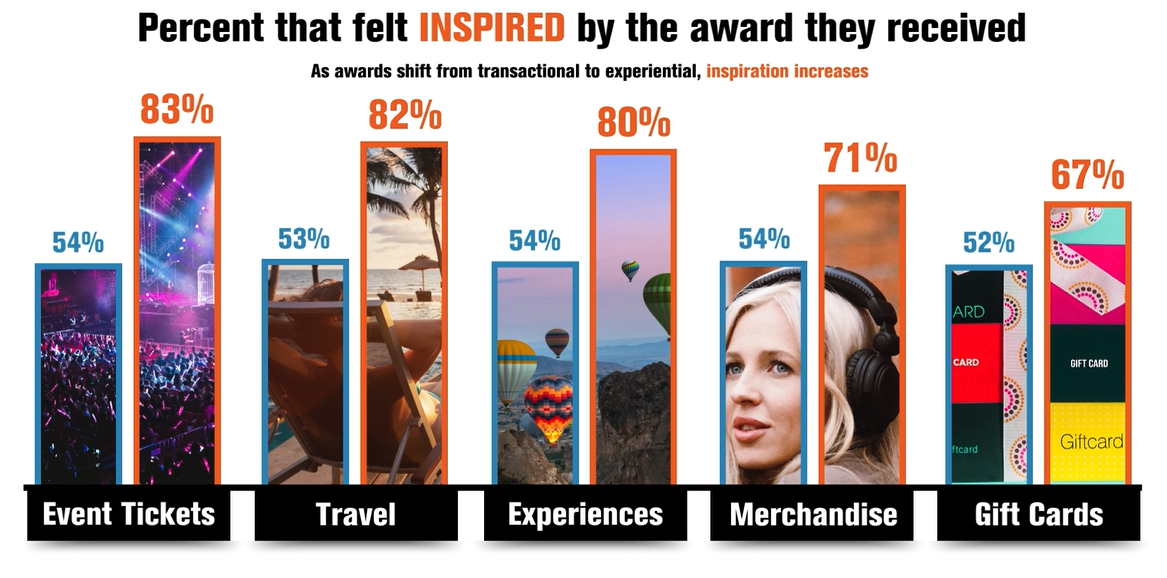What Rewards Are Most Effective?
We look at the what rewards are most effective in inspiring employees and motivating performance, and it might not be what you think.
Typically, when incentive program participants are asked about the types of rewards they prefer, they most often say cash. However numerous studies have shown that cash is not as effective in motivating higher levels of performance as experiences or merchandise.

What rewards are most effective: A summary of studies
Written by: Barry Danielson, VP, Decision Sciences; Neil Helgeson, Director, Insights Lab
(View Author Bio)
If you ask, they say: "Show me the money."
When incentive program participants are asked about the types of rewards they prefer, cash and cash equivalents vs. merchandise or experiences, they most often say cash is preferred. This is not surprising; cash is fungible – participants can use cash in any way they want. Given this stated preference, you might expect that cash is a better motivator. In fact, the opposite is true. Numerous studies have shown that cash is not as effective in motivating higher levels of performance as experiences or merchandise.

1. Major tire manufacturer
A major tire manufacturer looked at this question directly in their company owned stores. In half the stores (chosen at random), salespeople were rewarded with merchandise and travel rewards for selling particular products, while the other half received a monetary reward. The program lasted six months and while the cash group had a 22% increase in sales, the non-cash group realized a 32% increase1.
2. Hard goods manufacturer
A similar result can be seen with a major hard goods manufacturer's sales incentive program. One group received a cash award for reaching a self-selected sales goal, while a control group received points that could be used to obtain merchandise or experiences. The cash group awards were actually larger than the value of the points. In spite of that, 32% of the points group reached their goal compared to only 25% of the cash group2.
3. Call centre representatives
The same pattern was seen with call centre representatives who were rewarded for successfully collecting late payments. For each dollar in rewards, the non-cash group collected $165 in payments while the cash group collected $1313, a difference of 23%.
4. Window manufacturer
A window manufacturer realised the advantage of non-cash rewards when it compared a VISA debit card with travel and experience awards to incentivise salespeople. The non-cash group had 22% more closed sales per rep, larger order sizes ($4,436 vs. $4,305) and 25.2% higher overall revenue4.
5. Telecom provider
A major telecommunications provider tested both cash and non-cash and active and passive rules designs. Three levels of goals were determined by a percentage increase over the expected baseline. In one group participants actively selected their desired goal level. This was the “active” structure. In the second group, the three levels were simply tiered – recipients were rewarded based on the level they achieved without having to select/ commit. This was the “passive” structure. Both merchandise groups exceeded their baseline – the passive group by 13% and the active group by a whopping 87%! The Cash Groups were under baseline (by 3% active and 35% passive). Overall, the cash group was 16% under baseline, which was worse than a control group that had no program at all (-4%)5.
6. Frozen food manufacturer
Replacing a merchandise and cash incentive program with a cash only program equal in cost to the cash/merchandise program proved costly to a frozen foods manufacturer. After implementing the cash only program, sales DECREASED 4.36%. This was attributed to a reduction in effort by the salespeople6.
____________________
Cash and participant mindset
In a series of eight studies in an academic setting, participants in a cash condition who were asked to perform tasks such as solving anagrams responded by setting lower goals and taking on less challenging tasks, compared to participants who were awarded with non-cash inducements.
Non-cash awards can also provide multiple long-term motivational benefits. While it is not socially acceptable to brag about cash awards, sharing non-cash awards and experiences with family and friends is perfectly acceptable and reinforces the motivational effect. Cash awards also usually end up combined with other income, losing the connection to the effort needed to achieve the award. However, earning a trip to Hawaii creates memories that can last a lifetime, and awards used frequently like golf clubs or electronics will remind participants of who rewarded them and what it took to receive their award. Merchandise and experiences are more motivating, create a more positive mental approach and result in a longer-term positive impact.
If more proof was needed, the recent BI WORLDWIDE research on New Rules of Engagement also looked at how non-cash rewards were seen by employees as more inspiring to receive vs. more transactional rewards like cash and gift cards.

____________________
1. The Trouble with Money, Tom K Gravalos and John M Jack, ©2009
2. Barry Danielson and Neil Helgeson, BI WORLDWIDE, 2023
3. Monetary vs. Non-Monetary Awards: Comparative Studies ©BI WORLDWIDE 2012
4. The impact of goal setting and rewards on performance, BI WORLDWIDE 2012
5. The impact of goal setting and rewards on performance, BI WORLDWIDE 2012
6. Is Cash King for Sales Compensation Plans? Evidence from a Large Scale Field Intervention, George John, Ph.D., University of Minnesota, 2017
7. Cash (Dis)Incentives, Rachel Meng and Ran Kivetz, 2019
____________________
Be inspired...
Visit our blog and explore the stories we share.












